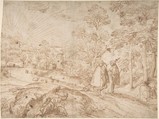Landscape with Two Pilgrims Walking Along a Road
Attributed to Pieter Balten Netherlandish
Not on view
As the sun is setting behind the hills in this rural landscape, two pilgrims encounter a shepherd and his flock, sitting along a sandy road. Further in the background, cows are grazing the pasture, and a figure is fishing in a creek near some cottages. This harmonious pastoral scene was presumably created by the Netherlandish artist Peeter Baltens, active in Antwerp in the mid-sixteenth century. Baltens worked in close vicinity of Pieter Bruegel the Elder (ca. 1528–1569), who was his junior by a few years, and possibly assisted in his studio.[1] Baltens’s works show strong similarity to both Bruegel and other contemporaries such as Hans Bol (1534–1593), which is why the attribution of several of their drawings – including this one – are topic of ongoing discussion.
A corpus of thirteen drawings is tentatively associated with the artist. This Pastoral Landscape, which previously was thought to be by a follower of Bruegel, is currently ascribed to Baltens.[2] Stylistically, this attribution is supported by the distinctive, angular lines visible in the rendering of the animals, which also appear in Landscape with a Horseman and Herd in the Staatsgalerie in Stuttgart, and Forest scene with Farmhouses and Grazing Cattle in Museum Boymans van Beuningen in Rotterdam.[3] Baltens’s hand is equally recognizable in the distinctive horizontal, curved hatchings used to delineate the slender stems of the trees in the foreground, as well as the depiction of foliage.
The most puzzling elements in this composition are the human figures depicted and the difference in their appearance. The physiognomy and size of the two travelers on the road are strikingly Bruegelian and differs drastically with the figure of the herd. Moreover, the herd and his flock were drawn on top of the already extant elevation in the landscape, which suggests that this group was done in a second campaign, albeit in the same ink. By inserting the herd, who is looking up over his shoulder to the people passing by, the suggestion of a social interaction was obtained. Perhaps Baltens made this insertion on second thought, to liven up his composition.
[1] S. Hautekeete, ‘Heeft ook verscheyden Landen besocht en verscheyden ghesichten nae t’leven gedaen’: drie nieuw ontdekte tekeningen van Peeter Baltens (Antwerpen 1527?-1584?)’, in A. Balis et al., Florissant. Bijdragen tot de kunstgeschiedenis der Nederlanden (15de-17de eeuw). Liber Amicorun Carl Van de Velde, Brussels: VUBPress, 2005, p. 185.
[2] R. Jung, "Peeter Baltens, a forgotten draughtsman of the Bruegel circle: His landscape drawings," Nationalmuseum Bulletin Stockholm 9 (1985), pp. 46-49; the attribution is supported by Stephen J. Kostyshyn, who published the monograph on Baltens’s work.
[3] Attributed to Peeter Baltens, Landscape with a Horseman and Herd, pen and brown ink, Stuttgart: Staatsgalerie, inv. no. C 1990/4002, and Forest scene with Farmhouses and Grazing Cattle in Museum Boymans van Beuningen in Rotterdam (inv. no. N97).
Due to rights restrictions, this image cannot be enlarged, viewed at full screen, or downloaded.


